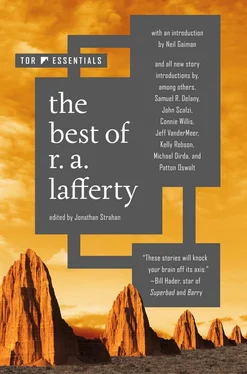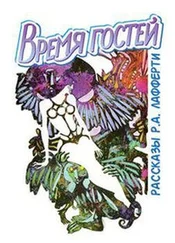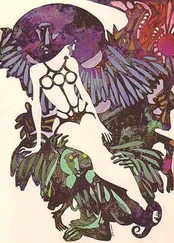The Best of R. A. Lafferty
Edited by Jonathan Strahan

Not to Mention R. A. Lafferty: A Personal Introduction
Neil Gaiman
Objectivity is a good thing. We rely on our commentators, our observers, our critics to be objective. It’s what makes a critic a good critic and a reviewer a good reviewer. We trust them to tell us about books and films, music and authors.
You cannot trust me to tell you anything about R. A. Lafferty. It would be like asking a string tuned to G to give its opinion on the strings of a lower octave. When it hears another G, it’s going to thrum in joyous recognition. That’s the way of it. It’s just how it is.
I was about nine years old, and somebody had left a copy of Judith Merril’s SF-12 in our house. I don’t know who. It might conceivably have been my father’s. Whoever owned it, I appropriated it, and proceeded to have my mind turned inside out. William Burroughs and Samuel R. Delany, Carol Emshwiller and Kit Reed, Brian Aldiss and Harvey Jacobs and John Updike and Tuli Kupferberg, J. G. Ballard and Hilary Bailey, Sonya Dorman and Tommaso Landolfi, none of them authors one would automatically recommend to nine-year-olds. I didn’t care. I read the stories and took what I could from them. I had a bunch of new favorite authors. I had new rules about what fiction could be. The Brian Aldiss short story, “Confluence,” was a dictionary. And one of the two stories by R. A. Lafferty was a school curriculum.
It was called “The Primary Education of the Camiroi,” and it was the curriculum for the schools of an alien race, who would need to learn how to create life and run planets as part of their schooling. It was really funny. It also struck several nerves with me. I was certain that they should be teaching us that sort of thing in school anyway.
The second story, “Narrow Valley,” was one of the best things in the book, and one of my favorite short stories to this day. It’s a tall tale, about a beautiful valley that’s, well, narrow. It told me things about America and Native Americans, about scientists, about ways of viewing the world, even things about magic, that spoke to me and made me happy.
When I was ten my father brought me copies of three of the Carr-Wollheim World’s Best Science Fiction collections, all the way from America. I read “Nine Hundred Grandmothers,” and “In Our Block.” I read “Thus We Frustrate Charlemagne.” I was in love.
I was also lucky. Why the library in the little Sussex town I lived in had, on their shelves, all the R. A. Lafferty books published in the UK in hardback by Dennis Dobson & Co is still a mystery to me. Someone who ordered books had good taste, I suppose. But they had them. I read, and loved, Fourth Mansions (a story about secret societies and animals and men with hairy ears) and The Reefs of Earth (about a family of alien children who are stranded on Earth) and Space Chantey (which is the Odyssey set in space). (All of these descriptions are at best incomplete and at worst wildly misleading.) I remember the world-shaking moment when I realized that the contents page of The Reefs of Earth , the chapter titles, actually rhymed and made a poem. I remember the joy I took in this.
I bought my own copy of the paperback of Nine Hundred Grandmothers , the first Lafferty short story collection, from Dark They Were And Golden Eyed, in Berwick Street. I made all my friends read it. As far as I was concerned, Lafferty was the most interesting author out there: I loved what he did with words. I loved the tune of the sentences, the way they sang and jigged and the sheer delight the author took in words.
For Christmas in 1978 my parents gave me a copy of The Encyclopedia of Science Fiction , edited by Peter Nicholls and John Clute. I did not know at the time that Peter and John would, each in their own way, become close and valued friends. I did not know that I would one day, write with John Clute the entry on Lafferty for the second edition of The Encyclopedia of Science Fiction . All I knew was there were lots and lots of Lafferty books listed that I had not read and did not know existed. I spent years happily hunting for them, not knowing that most of them were, at the time of writing, actually unpublished, something that would drive Clute and Nicholls to distraction.
I was twenty-one, and I did not know what I wanted to do or to be, but I suspected that I wanted to be a writer. The only story I had completed by then was an R. A. Lafferty pastiche. In the back room of the same library in which I had found the Lafferty books was an Author’s Who’s Who . I looked up Lafferty in it, knowing that he would not be in there. There was an address listed, in Tulsa, Oklahoma. I would never have dared to write to an agent or a publisher, but this looked like a home address.
I wrote him a letter, and with it, I sent the story.
The address was out of date, but the letter was eventually forwarded and it reached him, and to my genuine astonishment, he wrote back, thanking me for the “pretty good sketch or pastiche or something, not a short story, however, although the title page says that it is. It might be saleable, depending on the quirks of the market when you send it out. A good piece wakens a spark of recognition in every breast, so somebody once said. This, of course, wakens a special spark of recognition.” And he added, “Why don’t you write another piece or two? Things are fun to write and there doesn’t have to be any other reason.”
My favorite writer told me I should write some more, so I did.
I wanted to write an article about him, but nobody wanted to publish it, back then. Still we wrote back and forth, and I asked impertinent questions about writing and his work, and he answered them as best he could.
There are few enough authors who simply make me happy. There are authors who make me think, or who trouble me in good ways, or make me worry for their characters. Lafferty did those things, and did them so very well. But he does more than that. I start to smile with pleasure when I start reading a Lafferty story. It’s the way the tale is told, the voice of the teller, that brings me so much joy.
There isn’t anyone out there with whom it’s easy to compare Lafferty: Avram Davidson wrote unclassifiable and brilliant stories, and knew more of the world, but his stories did not feel like tall tales, nor were they such great lies told with so straight a face. The Irish novelist Flann O’Brien (aka Myles na Gopaleen, real name Brian O’Nolan) did the tall tales and the straight-faced lies, but he didn’t take us so far out of this world. Gene Wolfe is as deep, but seldom as funny.
I read all the Lafferty I could. I followed him as the work got darker, then more personal. I followed him from the big publishers to the small presses and the pamphlets. I read the work that I understood and the work that I didn’t (I suspected it was being written for an audience of only himself, but even then, I took joy in the sentences and the world). I have seen Lafferty’s office door, on display in a museum in Tulsa, Oklahoma.
What else do you need to know? And as I write that, it occurs to me that I’ve missed out all the biographical stuff, the important information I am sure you actually need in an introduction like this.
Raphael Aloysius Lafferty, Ray to his friends, was from Tulsa, Oklahoma. He trained as an electrical engineer and worked for an electrical supply company until he retired, aged forty-five. He was a professional writer from then until he retired again. He was Catholic (“Catholicism plays a big part in my life. Without it I would be in the gutter entirely. With it, I have only one foot in the gutter.”) and an alcoholic (“Drinking has influenced my writing all in the wrong direction. I am an alcoholic and shouldn’t drink at all. But once or twice a year I forget this and the results are usually sad. More of my writing has been ruined by my drinking than improved by it. Yet there’s always a goose there, it’s part of the ‘to seek and not to find’ motif. Somewhere, somewhere there must be this mind-expanding elixir! Such delusions are part of life. When I was younger I got a lot of pleasure and companionship out of drinking, but probably no creative impetus.”)
Читать дальше





![Рафаэль Лафферти - Дни, полные любви и смерти. Лучшее [сборник litres]](/books/385123/rafael-lafferti-dni-polnye-lyubvi-i-smerti-luchshe-thumb.webp)
![Рафаэль Лафферти - Лучшее [Сборник фантастических рассказов]](/books/401500/rafael-lafferti-luchshee-sbornik-fantasticheskih-ra-thumb.webp)